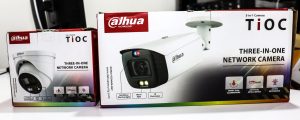Do CCTV cameras do more than the human eye? Leave a comment

The human eye can see things at an incredible resolution estimated at 576 megapixels. That huge number would have seemed insurmountable years ago when digital technology struggled just to cross the megapixel barrier. Today, even digital cameras are often as high as 16 megapixels, with the upper end of the market offering 80 megapixels.
As camera technology evolves, it’s certain that images that are considered cutting-edge today will seem run-of-the-mill tomorrow. This got us thinking — what will the camera of the future be like?
As camera manufacturers, we are constantly striving to get the highest-quality footage we can, and what is possible with today’s technology is truly incredible. For instance, it is already possible to produce images with more than a gigapixel, but these are normally achieved by stitching together a sequence of images. Therefore, it’s not possible to produce moving footage at that sort of resolution.
The other issue is storage; a gigapixel image takes up a lot of room. Even if it were possible to capture footage of that resolution, the camera that filmed it would need to contain some weighty storage just to record that much data.
We are not quite there yet. Having said this, the same could have been said a decade ago about today’s technology, and with storage solutions and image resolution improving so fast, what may look difficult today looks eminently realistic tomorrow.
We don’t have surveillance cameras that can surpass the human eye yet, but given enough time, I’m absolutely certain that threshold eventually will be crossed.
Even though the resolution isn’t quite there, in many ways, cameras can already do more than the human eye. IP surveillance cameras can already see beyond the spectrum of light visible to the human eye. With infrared lights, many outdoor-ready network cameras can see what the human eye would perceive as pitch black.

Surveillance technology has also made leaps and bounds over the last 20 years or so. Gone are the grainy images so stereotypical of analogue CCTV cameras. Today 1,080p HD footage is commonplace among modern IP surveillance cameras. When twinned with optical zoom levels that can reach 36x, this means that, even though 576 megapixels are still some distance away, cameras can already see distant objects more clearly than the human eye.
Are surveillance cameras perhaps already better than the human eye? They can’t quite get the same resolution yet, but the features we’ve covered only scrape the surface of what they can already achieve. I’m confident that eventually, the resolution of cameras will far exceed the human eye. Until then, nature will continue to get a run for its money.

